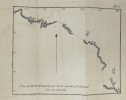- Home page
- Search by criteria
- author : marion du fresne crozet julien rochon abbe alexis marie de redacteur
1 books for « marion du fresne cro... »Edit
[BARROIS L'AINE] - MARION DU FRESNE , CROZET (Julien) , ROCHON (Abbé Alexis-Marie de, rédacteur).
Reference : PHO-455
(1783)
Nouveau voyage à la mer du sud commencé sous les ordres de M. MARION, chevalier de l'Ordre Royal & militaire de S. Louis, capitaine de brûlot ; & achevé, après la mort de cet Officier, sous ceux de M. le Chevalier Duclesmeur, garde de la Marine. Cette relation a été rédigée d'après les Plans & Journaux de M. CROZET. On a joint à ce voyage un Extrait de celui de M. De Surville dans les mêmes Parages.
A Paris, Chez Barrois l'aîné, 1783. In 8° ( 195x120) Relié plein veau époque, pièce de titre rouge, dos lisse orné , tranches rouges . VIII, 290 pp, illustré de 2 cartes dont 1 repliée h.-t. et 5 pl. h.-t. , Complet du dernier feuillet, extrait du privilège à la date du 11 mai 1782, établi par Condorcet secrétaire de l'Académie des sciences.
Bel exemplaire et Édition originale excessivement rare. Une des premières expéditions en Nouvelle-Zélande et Australie. Le but du voyage était de ramener Mayao (Aoutourou), un tahitien qui avait navigué avec Bougainville en France en 1769 et subsidiairement pour dispenser la découverte du grand continent du sud « terres australes » avec pour mais stratégique de contrecarrer l'établissement des Anglais. Mettant les voiles en 1771, Mayoa mouut précocement près de Madagascar. Après avoir navigué à l'île Maurice en octobre 1771, l'expédition mit les voiles vers le sud où ils découvrent les Îles Crozet en janvier 1772. Le mois suivant, l'expédition arriva en Tasmanie et continuant vers l'est, il explore la côte de la Nouvelle-Zélande . Les Maoris leur font bon accueil mais après quelques semaines, un événement -- qui n'a jamais été réellement éclairci -- provoquent le massacre de Dufresne et d'une dizaine de ses hommes, tués et sans doutes mangés. Le reste de l'équipage, après avoir incendié le village où des restes humains sont retrouvés, parvient à fuir cette "fameuse baie des Assassins" et poursuit sa route vers les îles Mariannes et les Philippines pour préparer le retour vers l'Île de France (île Maurice) en 1773 . La relation de Crozet, plus qu'un simple émissaire et est une longue et importante description de la Nouvelle Zélande avec les moeurs et coutumes des Maoris et marque le début de l'ethnologie de Tasmanie . L'ouvrage a été publié par l'astronome et navigateur Alexis Marie Rochon. Premières planches sur la Nouvelle-Zélande First edition of an important Pacific Voyage, the “first French voyage of exploration actually to reach Australia” (Davidson) and in some sense a continuation of Bougainville s expedition. Under the command of Marc-Joseph Marion-Dufresne, and largely financed by him, the expedition comprised two ships, the Mascarin, with Marion as captain and Julien marie Crozet as second-in-command, and the Marquis de Castries, with the young aristocrat, Ambroise Le Jar du Clersmeur, as captain. Sailing south and then east from Cape Town they discovered the Crozet Island, then reached Van Diemen's Land, where they explored and mapped part of its southern coast. Marion and his officers were the first Europeans to make contact with the Aborigines there and Crozet's book incorporates the first extended account of the Tasmanians and, indeed, of any Australians Aboriginal group. Following his comparatively brief stay in Van Diemen's Land, Marion went on to make a lengthy stay in New Zealand. Here the captain and 26 of the crew were massacred by Maoris at the Bay of Islands. Upon Marion's death, Crozet took command of the Mascarin but the inexperienced 22-years-old aristocrat du Clesmeur took (ineffectual) command of the expedition and In the end the two ships returned to France. The discovery of the Crozet Island and the further charting of Van Diemen's Land (recorded in one of the maps here) were significant contributions to South Sea Discovery. The contact between the French and the Aborigines of Van Diemen's Land marked the beginning of Tasmanian (and Australian) ethnography. The great importance of the voyage for early history of New Zealand is made clear by Bagnall: apart from the drama of its story, (Crozet's narrative) has much careful observation on Maori life and custom and, with the reports of Cook and his officers , was virtually the only source material available (Davidson), Bagnall, 1502; Davidson, pp.98-9; Hill 2, 401; Hocken, pp.21-2; Kroepelian, 1104; Sabin, 72371.
 Write to the booksellers
Write to the booksellers



